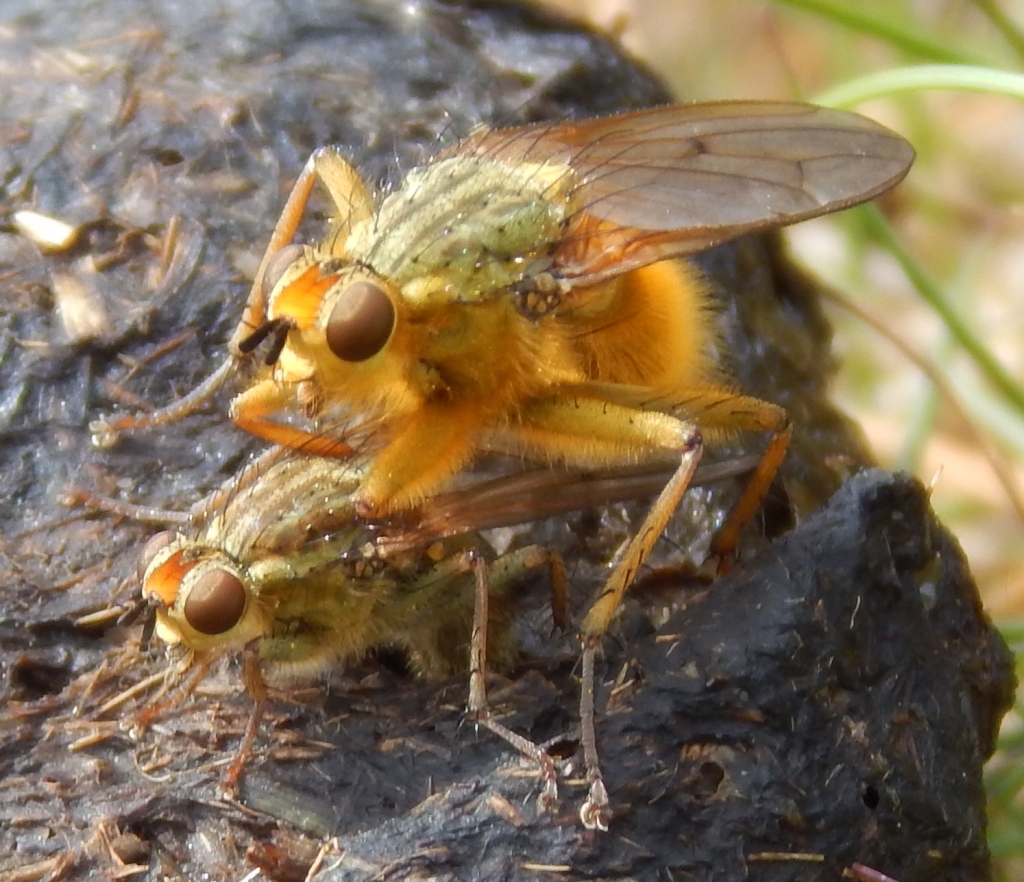
[310] Scathophaga stercoraria, Yellow Dung Fly
Introduction
Scathophaga stercoraria, the Yellow Dung Fly, is a very common fly found throughout the World wherever there is agricultural livestock. It plays an important role in the natural decomposition of dung.
It may also be called the Golden Dung Fly.
Taxonomy
Kingdom – Animals
Phylum – Arthropods
Class – Insects
Order – Diptera (Flies)
Suborder – Brachycera
Infraorder – Muscomorpha
Section – Schizophora
Subsection – Calyptrates
Superfamily – Muscoidea
Family – Scathophagidae (Dung Flies)
Subfamily – Scathophaginae
Genus – Scathophaga
Scientific Name – Scathophaga stercoraria
Name
Scathophaga comes from Latinized Ancient Greek scato-phaga meaning dung-eating. Stercoraria seems to be another Latin word relating to dung.
Flies
The time has come to consider the world of Flies. We start, of course, by excluding Butterflies, Damselflies, [036] and [046] Sawflies, [247] Scorpionflies, Caddisflies, Alderflies and all the other insects that have acquired the word ‘fly’ as part of their name, but are not true flies.
There may be as many as a million species within Diptera, of which about 150 000 have been formally identified so far. They undergo full metamorphosis. Larvae may be parasitic, affecting molluscs, millipedes, insects, mammals or amphibians, or may feed on plant matter, fungi, or dead matter. Many larval species are aquatic. Some species of fly have larvae that develop, and even go through moults, before emerging from the mother to pupate immediately. The larvae of some types of flies are called maggots.
For most species the adult stage is short, just long enough to mate and lay eggs (a fate shared with many other insect species.)
Some of the more recognizable and well-known subdivisions include the following.
- Crane Flies. See [235] Nephrotoma and [341] Tipula
- Mosquitos, Midges and Gnats. Small and generally unwelcome because they fly around in large numbers. Some, but not all species are biting. Mosquitos form a single family but midges and gnats are loosely defined terms covering several families and several thousand species.
- Fruit Flies. Even smaller than midges and gnats, another 5 000 species.
- Horse Flies. These are the largest ones you will see in the UK. See [334].
- Hoverflies – considered in [205] Leucozona and [361] Volucella but mostly in [333] Syrphus.
- House Flies. About 4 000 species in the family Muscidae are the ordinary insects that look like typical flies and can be seen in and around houses.
- Blow flies such as bluebottles. Calliphoridae are fairly similar to Muscidae and some are common outside houses.
It won’t surprise you that taxonomy is sometimes uncertain and changing, and some long-established families and other groups may be polyphyletic.
Because it appeared earlier, I have to mention [053] the Bee Fly.
I have excluded most flies from these blogs because they are numerous and complex. At least 7 000 species may be found in the UK and most can only be identified to species level with the help of microscopic examination of their genitalia and other parts.
Description
The family Scathophagidae are called Dung Flies although only a few species of Scathophaga spend their larval stages in dung.
Scathophaga stercoraria males are golden yellow in colour with orange-yellow fur on their front legs. Females are a little smaller, duller in colour with some green-brown tinges and no brightly coloured fur on their legs.



The adults of Scathophaga stercoraria feed on other insects, mostly smaller flies. Females forage in vegetation and only visit dung to mate and lay their eggs. The males stay on the dung waiting for females.
Eggs are laid in the dung and the larvae feed on it. They burrow below it to pupate.
Habitat
Scathophaga stercoraria is common over much of the Northern Hemisphere and is found where there are wild or farmed [130] horses, [054] cattle, [245] sheep, [077] deer, [328] pigs or wild boar. Their preferred habitat is fresh cattle dung.
See also
See the text above for some other flies. You may be able identify some without microscopic dissection as long you have a good enough camera to be able to count the hairs on their legs.
